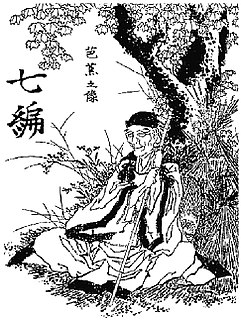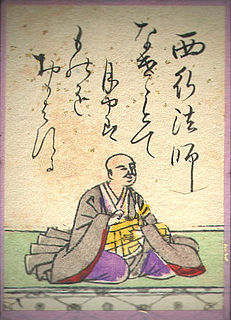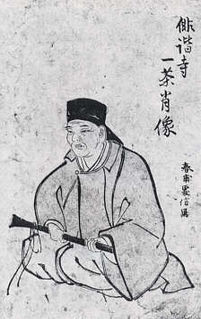Related Research Articles

Haiku is a type of short form poetry originally from Japan. Traditional Japanese haiku consist of three phrases that contain a kireji, or "cutting word", 17 on in a 5, 7, 5 pattern, and a kigo, or seasonal reference. Similar poems that do not adhere to these rules are generally classified as senryū.

Matsuo Bashō, born Matsuo Kinsaku, then Matsuo Chūemon Munefusa, was the most famous poet of the Edo period in Japan. During his lifetime, Bashō was recognized for his works in the collaborative haikai no renga form; today, after centuries of commentary, he is recognized as the greatest master of haiku. He is also well known for his travel essays beginning with “Records of a Weather-Exposed Skeleton” (1684), written after his journey west to Kyoto and Nara. Matsuo Bashō's poetry is internationally renowned, and, in Japan, many of his poems are reproduced on monuments and traditional sites. Although Bashō is famous in the West for his hokku, he himself believed his best work lay in leading and participating in renku. He is quoted as saying, "Many of my followers can write hokku as well as I can. Where I show who I really am is in linking haikai verses."

Noh is a major form of classical Japanese dance-drama that has been performed since the 14th century. Developed by Kan'ami and his son Zeami, it is the oldest major theatre art that is still regularly performed today. Although the terms Noh and nōgaku are sometimes used interchangeably, nōgaku encompasses both Noh and kyōgen. Traditionally, a full nōgaku program included several Noh plays with comedic kyōgen plays in between; an abbreviated program of two Noh plays with one kyōgen piece has become common today. Optionally, the ritual performance Okina may be presented in the very beginning of nōgaku presentation.
Zeami Motokiyo, also called Kanze Motokiyo, was a Japanese aesthetician, actor, and playwright.

Oku no Hosomichi, translated alternately as The Narrow Road to the Deep North and The Narrow Road to the Interior, is a major work of haibun by the Japanese poet Matsuo Bashō, considered one of the major texts of Japanese literature of the Edo period. The first edition was published posthumously in 1702.

Saigyō Hōshi was a famous Japanese poet of the late Heian and early Kamakura period.
Haibun is a prosimetric literary form originating in Japan, combining prose and haiku. The range of haibun is broad and frequently includes autobiography, diary, essay, prose poem, short story and travel journal.

Kobayashi Issa was a Japanese poet and lay Buddhist priest of the Jōdo Shinshū. He is known for his haiku poems and journals. He is better known as simply Issa (一茶), a pen name meaning Cup-of-tea. He is regarded as one of the four haiku masters in Japan, along with Bashō, Buson and Shiki — "the Great Four."
Makoto Ueda was a professor emeritus of Japanese literature at Stanford University.

The Sessho-seki, or "Killing Stone", is an object in Japanese mythology. It is said that the stone kills anyone who comes into contact with it.
Aoi no Ue is a Muromachi period Japanese Noh play based on the character Lady Aoi from the Heian period novel The Tale of Genji. It is an example of the fourth category of "miscellaneous" Noh plays. Aoi no Ue was the first of many Noh plays based on The Tale of Genji. It is sometimes attributed to Zeami Motokiyo or to his son-in-law Zenchiku; the extant version of the text is likely a reworking of a version written for the troupe of a contemporary, Inuō.
Jo-ha-kyū (序破急) is a concept of modulation and movement applied in a wide variety of traditional Japanese arts. Roughly translated to "beginning, break, rapid", it essentially means that all actions or efforts should begin slowly, speed up, and then end swiftly. This concept is applied to elements of the Japanese tea ceremony, to kendō and other martial arts, to dramatic structure in the traditional theatre, and to the traditional collaborative linked verse forms renga and renku.
Konparu Zenchiku was a skilled Japanese Noh actor, troupe leader, and playwright. His plays are particularly characterized by an intricate, allusive, and subtle style inherited from Zeami which convolved yūgen with influences from Zen Buddhism and Kegon. Actors should strive for unconscious performance, in which they enters the "circle of emptiness"; such a state of being is the highest level of artistic or religious achievement.
Miura Chora was a Japanese poet raised in Ise, in the Mie Prefecture of Shima Province on the island of Honshu, Japan. He traveled throughout the country composing poems and helped lead the Matsuo Bashō revival movement of the eighteenth century.
The Seashell Game is a 1672 anthology compiled by Japanese poet Matsuo Bashō, in which each haiku is followed by critical commentary he made as referee for a haiku contest. It is Bashō's earliest known book, and the only book he published in his own name. The work contains 60 haiku by 36 poets, including two by Bashō himself.

Rashōmon (羅生門) is a Noh play by Kanze Nobumitsu (c.1420). Like other celebrated dramas such as the Maodori-hasi and Ibaraki, it is based on the legend of Watanabe no Tsuna and the demon of Rashōmon.
Sarumino is a 1691 anthology, considered the magnum opus of Bashō-school poetry. It contains four kasen renku as well as some 400 hokku, collected by Nozawa Bonchō and Mukai Kyorai under the supervision of Matsuo Bashō. Sarumino is one of the Seven Major Anthologies of Bashō, and, together with the 1690 anthology, Hisago, it is considered to display Bashō's mature style (Shōfū) at its peak. Bashō's influence on all four of the kasen in Sarumino was profound and when he sat with Bonchō, Okada Yasui and Kyorai at Yoshinaka Temple to write "Kirigirisu", he extolled them, "Let's squeeze the juice from our bones."
Tagami Kikusha was a Japanese Early Modern literata (bunjin). Best known for her haiku poetry, she also wrote verse in Chinese, and was accomplished in the tea ceremony, koto, and ink painting.
Hori Bakusui 堀麦水 (1718-1783) was a major Japanese poet of the Matsuo Bashō revival, writing traditional style haiku poems.
Benkei on the Bridge is a Japanese Noh play from the 15th Century, by Hiyoshi Sa-ami Yasukiyo.